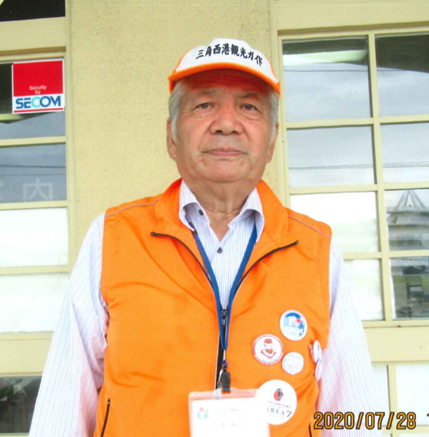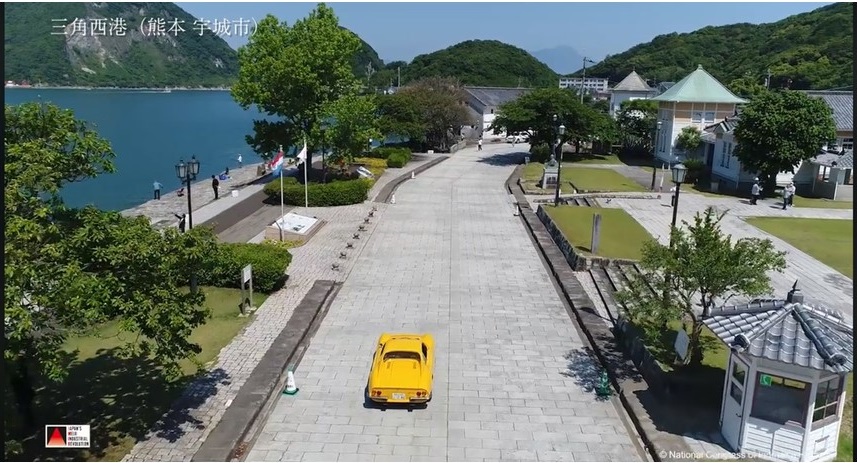PEOPLE
18 Years History of a Tourist Guide Business and an Outpouring of "Love for Misumi West Port." ~"Registration for World Heritage is Not Simply a Goal, but a New Starting Point."~

Chairman of the Tourist Guide Association of Misumi West Port
February 1949: Born in a town called Misumi-machi in Kumamoto Prefecture (currently known as Misumi-cho, Uki City)
March 1969: Graduated from Kumamoto Prefectural Fruit Tree Educational Institute (a junior college certificate)
October 1974: Completed the correspondence course approved by the Ministry of Education in agriculture workshop of the Department of Gardening in Tokyo University of Agriculture.
1986: Established “the Association to Ponder About Misumi” with the aim of making the most use of the Misumi West Port, and has taken office as chairman.
1999: Established “the Society for Considering the Culture and Literature of Misumi West Port” with the aim to designate the port as a national important cultural property, and has taken office as chairman of this association as well.
2002: Joined the Association of Misumi West Port Sightseeing Volunteer Guides Association (now known as the Misumi West Port Sightseeing Volunteer Guide Association), which was organized by the Misumi Tourist Association, and has been taken office as chairman since then.
He is the third generation of a farming household whose main business has always been in producing mandarin oranges, decopon (tangerine), and figs. His life motto is “If you do everything right, it will be a heavenly deed”
Mr. Manpo Saito is known as the leader of a volunteer tourist guides of Misumi West Port (Misumi-machi, Uki City, Kumamoto Prefecture), one of the constituent properties of the “Industrial Revolutionary Heritage of Meiji Japan.” He is not only a well-known professional guide typically referred to as a “living dictionary of Misumi West Port,” but also a local promoter who has been working hard for more than 30 years to designate the port as a national important cultural asset and UNESCO World Heritage Site. In addition, he has been actively involved in all community activities, such as in local government, education institutions, fire department, and the JA Group (Japan Agricultural Cooperatives). What motivates Mr. Saito—who loves the town of Misumi-machi and Misumi West Port, and who continues to devote all his energy in engaging in community activities on a daily basis—is his passionate wish to “make the most of this precious World Heritage Site for the sake of community to pass it on to the next generation.
■After Participating in the Symposium, he Established “the Association to Ponder About Misumi”.
--When did Mr. Saito start working as a volunteer guide at Misumi West Port?
Saito: It all started when I joined “the Association of Tourist Volunteer Guide,” which was set up by the Misumi Tourism Association before it was merged with Uki City in 2002. There were eight members at the beginning, but I am the sole one who continues to work there today.
--So that means that you must have been working as a guide long before Misumi West Port was registered as a UNESCO World Heritage Site of the Meiji Japanese Industrial Revolution, right?
Saito: That is right. At first, we began as volunteers, but there was a period when we had to pay for the service, so we made some changes, such as removing the word “volunteer” from the name of the association. Then in 2014, one year prior to the day it was registered as a world heritage site, we officially reestablished it as “the Misumi West Port Tourist Guide Association.” At that time, we recruited new volunteer guides, held two courses, and started with 18 people who passed the test. Although there are about 12 of us, I have been active as the chairman of the group in the meantime.

--Could you introduce us to some of the tourist routes you would like to recommend?
Saito: Of the three major masonry ports built in the mid-Meiji era, only Misumi West Port is still remaining today. But first of all, I would really like you to see this 765-meter-long masonry wharf. The three drainage channels that drained the water from the mountain are still maintained intact. Moreover, the old buildings in the area also remind us of the Meiji period. For example, the old buildings in the area still stand today, such as the Ryujo-Kan Hall and the old Misumi shipping warehouse. There are some that remained standing on top of the hill in the town block as well, such as the old Uto District Public Office and Old Misumi Summary Court. The attraction of Misumi is not only the West Port itself, but also includes the buildings that are still built with the most state-of-the-art technology of the time, which I think tourists will enjoy.
--Misumi West Port must be a source of pride for a resident like you, Mr. Saito.
Saito: Well, to tell you the truth, I did not know much about it before, and I was also not interested in it at all. The moment I got involved with Misumi West Port was when I participated in “the Misumi West Port Symposium,” which was held in 1983. This symposium was organized by the Professor Kiyoharu Horiuchi of Kumamoto University and other miscellaneous researchers, and it turned out to be a great success, with more than 500 people from all over Japan who were fans of Misumi West Port attending the symposium. It was from that moment that I became aware of the historical value of West Port, and I began to study it, because I realized that there was something so wonderful about Misumi. Then in 1986, I began “the Association to Ponder about Misumi” with ten other members.
--What kind of activities did you engage in exactly?
Saito: There are not enough places to have fun in Misumi. Therefore, we played around with the facilities at Misumi West Port, or rather, we held various fun events to attract more people. For example, in 1990 we held a “Gathering for Tea Ceremony and Koto (Japanese harp)” at the Hosokawa villa, which is an old building made in a style of samurai residence, and we invited about 50 companies to join us in holding an “Evening of World Food and Music,” where we provided 6,000 yen worth of food for 3,000 yen of membership fees. And that is how we did all sorts of various events at our own expense.
Director, National Council of Industrial Heritage
President, Duke Estate Co.Ltd.
Representative Director, National Congress of Industrial Heritage
(Honorary Advisor, Kyushu Railway Company (JR Kyushu)
Senior Researcher, Industrial Heritage Information Centre
Honorary Advisor, Nippon Mining Co., Ltd.
The Ambassador of Supporting Kamaishi Hometown
Former Director of Nagasaki City World Heritage Office
Former General Manager, Nagasaki Shipyard and Machinery Works, Mitsubishi Heavy Industries, Ltd.
Chairman, Fujisankei Group
Executive Managing Advisor, Fuji Television Network, Inc.
Executive Managing Advisor, Fuji Media Holdings, Inc.
Advisor, Federation of Japan Port and Airport Construction Association
(Ex. Chairman of Specialists Center of Port and Airport Engineering)
Mayor of Nagasaki City
Former Director of the Sano Tsunetami Memorial Museum (currently known as Sano Tsunetami and the Mietsu Naval Dock History Museum)
Director of NPO Association for Thinking about Satoyama
Director of National Congress of the Industrial Heritage
Honorary Chief Priest Toshinari Ueda
Former Mayor of Omuta City
Archaeologist and Heritage Conservation Specialist
A fellow of the Japan Federation of Engineering Societies
Team Member of the Industrial Project Team Office for the Promotion of World Heritage Listing under Cabinet Secretariat
Governor of Kagoshima Prefecture
Mayor of Hagi City
Mayor of Uki City, Kumamoto Prefecture
The Former Employee of Nippon Steel Corporation
An Associate Professor of the Faculty of Science and Engineering in Iwate University
Chairman of the Tourist Guide Association of Misumi West Port
President of Kuraya Narusawa Co., Ltd.
Chairman of Izunokuni City Tourism Association
Director and General Manager of Gunkanjima Concierge
Producer of the Gunkanjima Digital Museum
Owner at Tōge Chaya
Chairman: Mr. Hidenori Date
President: Mr. Masahiro Date
Proprietor, Houraikan Inn
Representative Director of Egawa Bunko non-profit incorporated foundation
The 42nd head of the Egawa Family
Democratic Party for the People (DPP) Representative for Nagasaki Prefecture
President of the NPO, Way to World Heritage Gunkanjima
Representative Director
MI Consulting Group
President of Watanabe Production Group and Honorary Chair of Watanabe Productions Co., Ltd.
Member of the House of Councillors
Governor
Kagoshima Prefecture
World Heritage Consultant
Director and Dean, The Kyushu-Asia Institute of Leadership
Representative Director, SUMIDA, Inc.
Journalist, founder of the Shimomura Mitsuko Ikikata Juku School
Representative, Rally Nippon
Chairman, Sites of Japan’s Meiji Industrial Revolution World Heritage Route Promotion Council Director, National Congress of Industrial Heritage
Representative Director, General Incorporated Foundation National Congress of Industrial Heritage (Advisor, Public Interest Incorporated Foundation Capital Markets Research Institute)
Mayor of Nagasaki City
Policy Director at Heritage Montreal
World Heritage Consultant
Executive Director of Kogakuin University
Heritage Architect and International Consultant
Head of Data Acquisition at The Glasgow School of Art’s School of Simulation and Visualisation
Head of Industrial Heritage, Historic Environment Scotland, Edinburgh
Scottish Ten Project Manager, Historic Environment Scotland, Edinburgh
Mayor of Izunokuni City, Shizuoka Prefecture
Pro-Provost and Chairman of Council of the Royal College of Art. Heritage advisor of Canal & River Trust for England and Wales.
Dean of Tokyo Rissho Junior College
Professor emeritus of Keio University
Mayor of Kitakyushu City
At the 39th session of the World Heritage Committee convened in Bonn, Germany, from June 28 to July 8, 2015, the decision was approved to inscribe the Sites of Japan’s Meiji Industrial Revolution on the World Heritage list.
At a celebratory party held to mark the occasion, some of the primary promoters of the project spoke of their joy in achieving their goal and of the trials and tribulations to getting there.
Director and Managing Executive Officer, Hanshin Expressway Company Limited
Member, Board of Directors, National Congress of Industrial Heritage
Vice-Governor of Shizuoka Prefecture
Mayor of Hagi City
Chairman, Tokyo Metro Co., Ltd.
Mayor of Omuta City
Deputy Director-General, Lifelong Learning Policy Bureau, MEXT
Former Counsellor, Cabinet Secretariat
Mayor of Kamaishi City
Member, Board of Directors, National Congress of Industrial Heritage Counselor, Shimadzu Limited
Chairman of the Consortium for the World Heritage Inscription of Modern Industrial Heritage (Kyushu-Yamaguchi) and governor of Kagoshima Prefecture (as of 2015)